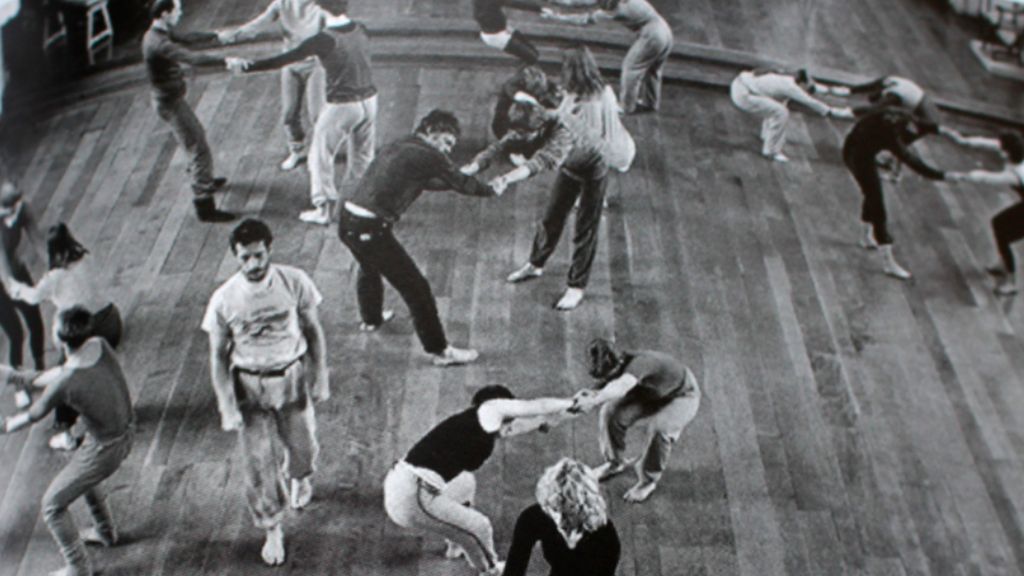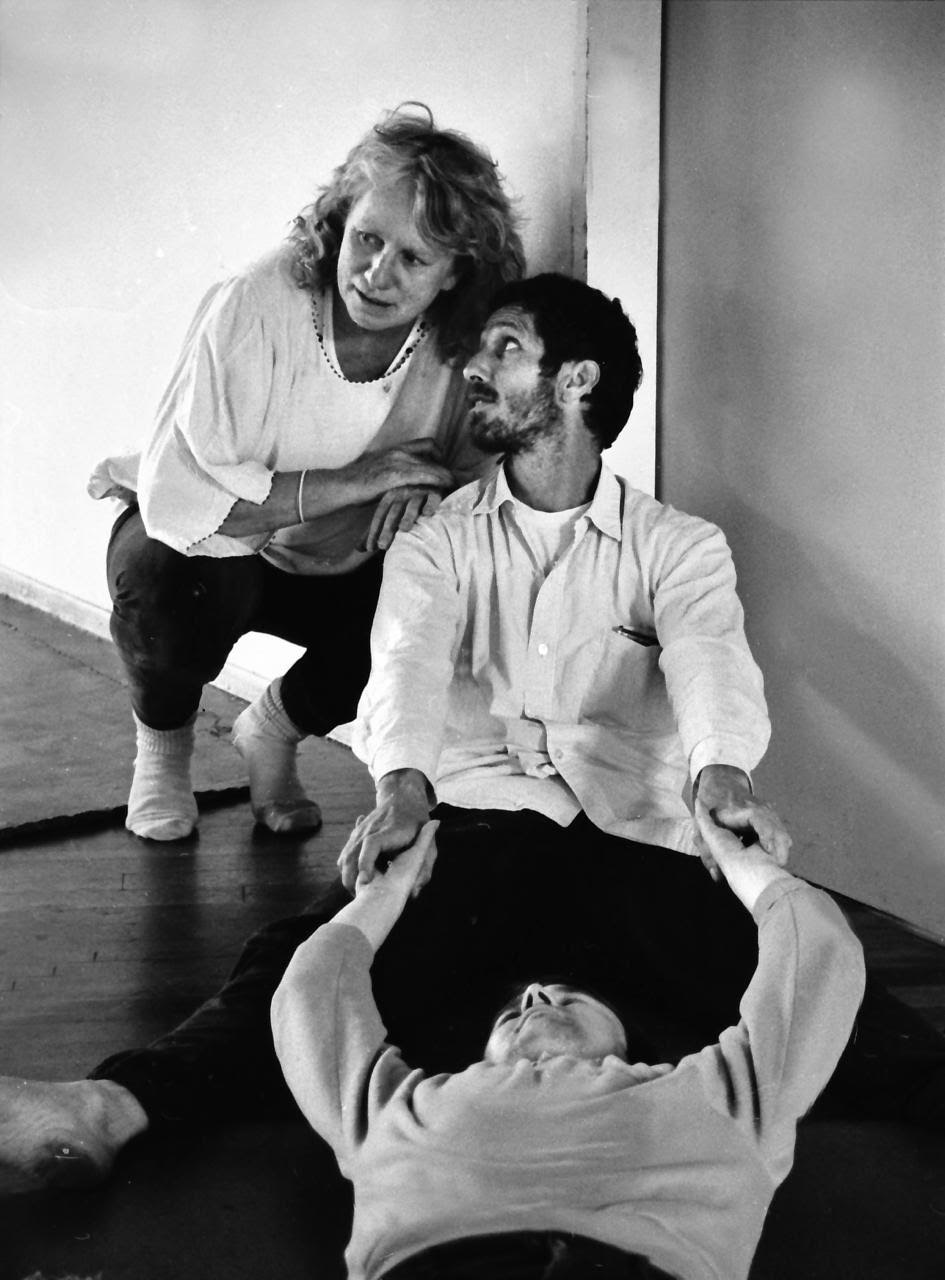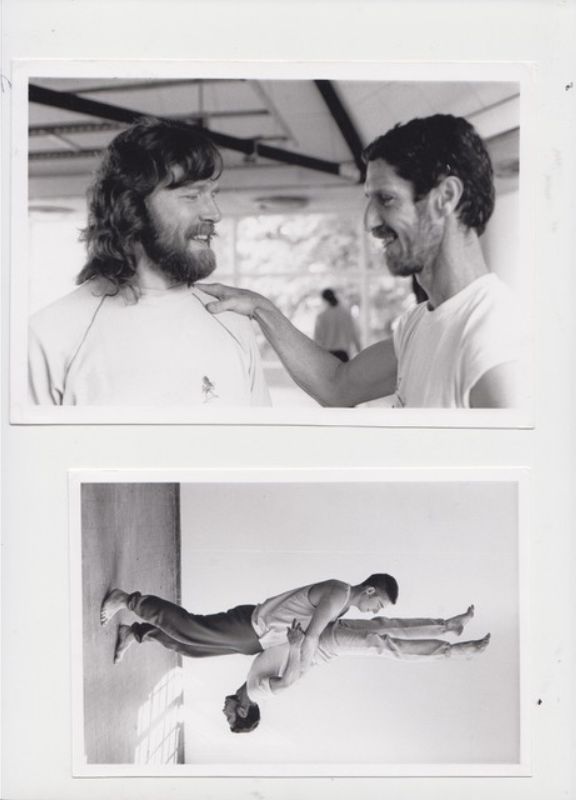‘The passing of Steve Paxton feels like a generational loss, of the life & soul that illuminated Dartington’s dance studios in the 1980s. I met him on ‘the drive’ on my first day in 1981, heading up the hill with that spring in his step. We sure loved him’. from Twitter by Alan Read

The world of dance, contemporary art and contact improvisation mourns as it bids farewell to Steve Paxton, a visionary and trailblazing artist, writer and dancer. He passed on 20 February 2024 in his home at Mad Brook Farm in Vermont, US.
Born in Phoenix, Arizona in 1939, Steve’s journey into dance began in high school with gymnastics and regular tournaments. After a year of university study in Arizona, he attended the American Dance Festival at Connecticut College in 1958 where he trained with José Limon and Merce Cunningham. The same year he moved to New York where he joined the José Limon company. In 1961 Steve joined the Merce Cunningham dance company where between 1961 and 1964 he worked alongside John Cage, Robert Rauschenberg and Jasper Johns. During the company’s European tour in 1964, the company performed on two evenings on 23 and 24 July, at the Barn cinema at Dartington which was Steve’s first introduction to the Dartington Estate.
Enmeshed in New York’s dance scene, in 1960 Steve joined a composition class at the Cunningham studio with composer Robert Ellis Dunn, together with Yvonne Rainer, Deborah Hay, Simone Forti, David Gordon, Lucinda Childs , Trisha Brown and others. It was a space for experimentation and untested dance forms with what dance performance could be, where it could take place along with improvisational thinking that was new to the dancers. It was a space where movements were deconstructed and the ordinary body had a place to be explored. In 1962, Dunn’s composition students began looking for a place to practice and perform their experiments. They settled at Judson Memorial Church where between 1962 and 1964 they produced a series of 16 performance evenings that became the influential Judson Dance Theatre, the revolutionary testing ground and a highly influential time for all dancers involved that had a ripple effect out into the dance/ art world.
At the end of the 60s, Judson dancers formed the improvisation collective Grand Union (1970-1976) where they investigated new territories of what it means to work collectively and what performative movement is and can be. In 1972 during a residency at Oberlin College with Grand Union, during a morning class, Steve introduced students to the small dance, where the main focus was not doing, but noticing what the body was doing while standing ‘still’. While at Oberlin, he created an all-male choreography titled Magnesium, which explored tumbling and falling with a soft landing and the opposite state of attention, standing “still”. It happened to be videoed and has since become an iconic piece—a moment where the beginnings of Contact Improvisation (CI) were born.
Directly after, Steve began teaching dance at Bennington College where he continued his investigation of falling and touch with students. In June 1972, he invited students from Bennington, Oberlin College and Mary Fulkerson’s students from University of Rochester NY, to a 2 week residency at the John Weber Gallery in NYC. He called the work in progress showings of practicing and developing a touch and falling-based dance activity “Contact Improvisations”. From that moment on Contact Improvisation (CI) continued to be developed by its practitioners and over decades has spread around the globe with thousands of dancers, countless groups and a rich expanding body of research. It remains up to this day, un-copyrighted and co-authored by its participants rather than by a choreographer and truly democratic in form. Despite a clearly defined technical approach, it always upholds at its core to this day, exploration, improvisation and deep listening. Contact Improvisation developed over its first ten years of teaching and performing in ensemble with many of the original Weber participants including Nancy Stark Smith, Danny Lepkoff, Nita Little, Lo Chapman and Curt Siddall. The next generation included, Karen Nelson, Andrew Harwood, K.J. Holmes, Peter Bingham, Dena Davida, and Ray Chung, who continued to spread the work through teaching, collaborating and performing.
In 1975, the Contact Newsletter was initiated by the California ensemble ReUnion, which included Steve, Stark Smith, Siddall and Little, as a place to share insights and keep an ongoing dialogue about the evolution of the practice rather than copyright and police its identity. After the first year of 5 issues, Stark Smith renamed the newsletter Contact Quarterly and began co-editing and producing the new journal with Lisa Nelson through the next 44 years. Steve continued as a regular contributor throughout and 45 years of his writings are available through CQ’s website. CQ became a highly influential journal dedicated to the dissemination of writings from the body, about improvisational dance forms and the field pf Somatics in dance. It grew and supported the network of teachers and practitioners around the world and was both a directory and a resource.
Steve developed countless choreographic and improvisational works during his lifetime. His early landmark pieces which celebrated the untrained human body very often tested audiences expectations with the explorations of pedestrian movements. Satisfyin Lover (1967), Flat (1964) and State (1968). His ongoing explorations of improvisational mind and dance were encapsulated in his solo Goldberg Variations (1986) by J.S. Bach played by Glenn Gould improvised by Steve Paxton” (1986 -1990) and in his collaborations with Lisa Nelson in their duet pieces : PA RT (1978 – 2002), and Night Stand (2004 – 2014). PA RT was first performed at Dartington College and premiered in its entirety at X6 in Butler’s Wharf in 1978.

Steve Paxton and Anne Kilcoye 1990ties Aller Park Dartington – photo by Kate Mount Touchdown Dance archives
At Dartington
In the mid 70s Steve was regularly invited to Dartington College of Arts, where Mary Fulkerson, a pioneer of Anatomical Release and participant in the first CI performances in 1972, was part of the theatre faculty in the newly established Theatre Studies degree. During these years, dance in Britain was undergoing a change, opening up to the new postmodern dance from the USA and experimenting with new forms of dance. While at Dartington, Steve taught on the newly established dance degree in 1977 and also performed at the Dartington Dance Festival which between 1978 – 1987 served as an incredible rich testing ground for new dance practices, choreographies, and dance research amongst the UK and international dance community. Dancers from far and wide would flock to Devon between May and June. It was a festival by dancers, for dancers, a unique space for cross pollination, teaching, learning, discourse, choreography, to show as well as perform each others work.
This decade of annual dance festivals was attended by hundreds of dancers from the UK and abroad. It grew a dynamic network of relationships, people, organisations and events which contributed to the broadening base of dance and reshaped what the UK dance landscape is today. Dancers who performed and taught included Mary Fulkerson, Richard Alston, Ellen Webb, Miranda Tufnell, Fergus Early, Julyen Hamilton, Emilyn Claid, Mary Prestige, Steve Paxton, Rosemary Butcher, Laurie Booth, Pauline de Groot, Patricia Bardi, Gaby Agis, Angus Balbernie, Kirstie Simson, Yolande Snaith, Katie Duck, Simone Forti, Caroline Waters and many more.
Dartington’s teaching artists substantially influenced the development of New Dance outside of Devon. In 1976 the X6 Collective was founded by Emilyn Claid, Maedée Duprès, Fergus Early, Jacky Lansley, Mary Prestidge and Sue Maclennan. A counter-cultural dance collective in London that established an entirely new structure and way of working outside of Britain’s mainstream ballet and contemporary dance institutions. In 1980 the X6 Collective’s home at Butler’s Warft was sold, and the collective moved and founded Chisenhale Dance Space in London, which up to this date continues to provides artist support, training and dance space to experiment. Steve was a regular guest at Chisenhale for many years. Experiments and Performances in these years were encapsulated in the New Dance Magazine (1977–88) which was published at Chisenhale.
In 1986, along with phsychotherapist and fellow theatre faculty member Anne Kilcoyne, Steve along with Dartington students started a project in the 2nd year of the theatre degree at Aller Park with visually impaired people from Torbay Royal National Institute for the Blind. After three years, Touchdown Dance Company was founded by Anna, Steve, Caroline Waters and Gerry Overington who was blind, offering and developing dance with the visually impaired through Contact Improvisation and touch. The company moved to the US for a while, in 1994 Katy Dymoke took over as director in the UK and it is still producing work today.
While Steve taught in Devon, as many new disability art groups came into fruition, Steve founded Touchdown Dance with theatre maker and psychotherapist Anne Kilcoyne in 1986, offering and developing dance with the visually impaired through Contact Improvisation and touch. The company comprising of Angus Balbernie, Caroline Waters, Jamus Wood and many more over the years, is still producing work today and was taken over by Katy Dymoke in 1994.
It was also in 1986 when he began developing his teaching of Material for the Spine, a technical examination of the use of the spine that he’d observed in CI. A practice that investigates the spine and pelvis as essential limb full of articulation. It inquires what the spine is doing in that improvisational sphere with another person, and offers a system for exploring the interior and exterior muscles of the back. In 2008 contredanse (Brussels) collaborated with him to produce a DVD, as an audio visual resource for his study of movement, including practices and guided explorations. Material for the Spine became accessible as an online interactive digital publication in 2019. In 2018 Contredanse published Steve’s first book Gravity, a collection of poetic essays.

Steve and Gerry Overington close up 1990ties Aller Park and Steve lifted by Bill Mc Kinlay 1992 photo by Kate Mount from Touchdown Dance archives
Awards
Over his lifetime and career Steve was honoured by a number of organisations. In New York he was awarded the Bessie award, and in 2014 he was awarded a Golden Lion for lifetime achievements in dance at the Venice Dance Biennale. He has received grants by the Rockefeller Foundation, The National Endowment for the Arts, The Contemporary Performance Arts Foundation, United States and a Guggenheim fellowship, and many more.
Speaking in an interview with Philip Bither at the Walker Art Centre in 2015 about his part in the evolution of dance history, he said that he felt both like a mutant and an evolver.
“The pleasure of moving and the pleasure of using your body is, I think, maybe the main point. And the pleasure of dancing with somebody in an unplanned and spontaneous way, when you’re free to invent and they’re free to invent and you’re neither one hampering the other – that’s a very pleasant social form.” Steve Paxton
Towards the end of his life Steve spent his time writing, participating in countless online events as guest artist and keynote speaker. Steve’s last public appearances in Europe where at the 2019 opening of an exhibition dedicated to his life’s work at Culturgest in Lisbon, Portugal. Steve Paxton: Drafting Interior Techniques, a retrospective exhibition of his work and legacy dedicated to the inner experience of the dancers, and the book launch of his book Gravity in 2019 in Brussels.
Steve spent his last years at his home of five decades at Mad Brook Farm in the mountains in Vermont. In a talk at the Judson Dance Theatre exhibition ‘The work is never done’ at Museum of Modern Art in 2018 he was asked about his life, and he replied “Every atom in the landscape in front of me that I look at every day is changing…I feel like it’s a living soup and I’m…kind of dissolving into its space.”
We will miss Steve, but his legacy lives on! This is to remember him & his work!
Many have danced and learned with Steve at Dartington, it would be lovely to hear some of your memories in the comments section below.
_________
Minou T. Polleros (Dartington alumni 2011/ Board member of the Institute of the Study of Somatic Communication founded by Nita Little (ISSC), Co-director of Movement Network South West and of IFEEA, International Forum for Eco-embodied arts. Minou is a dancer, researcher, organiser, producer & curator. With input from Colleen Bartley former guest co-editor of Contact Quarterly ’s CI Newsletter and London based independent dance artist. With special Thanks to Lisa Nelson, Mary Prestige, Angus Balbernie and Caroline Waters for conversation and fact checking.
Transcribed from this interview:
“ I think one of the reason why I got into dance is to finish my movement development. Because I have a hunger to find, to finish and explore, to do what babies do when they begin to move, a hunger of what movement is or can be. I think it provides a service to keep the search alive, in a culture which has engineered an environment which requires physical and sensorial suppression to exist in, most of the people who study dance aren’t ambitious to be dancers in fact, or aren’t serious about that ambition. I think they are trying to complete physicality that gets messed up by sitting 12 years in school or longer. Essentially, urban civilisation has cut us off from movement and sensorial development which would occur in a natural environment. The sense of smell is leaving, the sense of sight is rigidly controlled by reading, television. signage, school, by words everywhere you look in the city – in fact there are many kinds of controls or implicit visual messages how to interact with the city. Here there is more neon than nuance, food is advertised than hunted for, entertainment becomes divorces from ingenuity. I am not complaining because it is 50.000 years too late to change direction. I find cities very interesting places but when I return to the country, I am struck by the difference in what it required by the senses. It is appalling how we disuse the body. Dance reminds us about that, dance explores some of the physical possibilities, dance refocusses our focussing minds on very basic existence, time, space gravity, opens up to creativity – this seems to me a reminder of nature, of our natures and as such it provides a service to us in our physical doldrums it’s a wake up call to deadened urbanised, a stimulus to work habituated bodies, a promise to developing children, even those country folk who cope with the natural environment and use their bodies more and more often, fall into a routine and mould their bodies into tools from which creativity has departed, dance will remind them of their feet, their spines, their reach, I think it is good for us.” Steve Paxton
